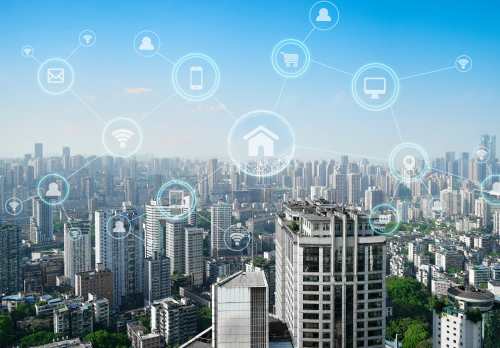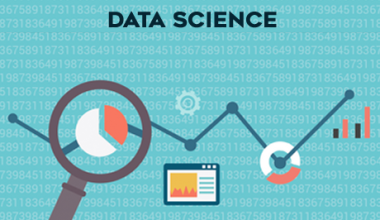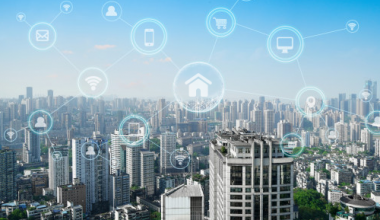Smart building technology refers to IoT (Internet-of-Things) technology and its applications for home automation & management. Also called Smart Home Management (SHM), Home Automation uses varied IoT-enabled devices and consumer IoT sensors that allow smooth automation processes within the home segment.
Smart building technology adopts multiple IoT-led advanced home automation applications that allow access management using smart locks, and energy conservation using smart thermostats or utility meters.
In the era of digital technology, smart buildings are the solution to multiple complex problems in the real-estate sector or residential/commercial building space. Just providing living space keeping occupants warm or cool, are no longer basic criteria, but providing the digital ecosystem integrating digital technologies like AI-IoT with buildings and commercial complexes is the current mandatory requirement.
IoT companies and varied other web and mobile app development companies are increasingly providing digital applications & advanced complex solutions such as smart buildings to fill the gap and stay updated in the sector.

What is Smart Building?
Smart Buildings are structures and architectures that are created using digital technologies mainly the IoT(Internet-of-Things) technology. This technology uses specific sets of hardware/physical devices like desktops, mobile phones/smartphones, etc., software like digital applications & digital solutions, and networking medium using internet technology that provides connectivity platforms to all, viz., managing HVAC (Heating, Ventilation, Air Conditioning), security, lighting, home gardening management, and so on.
IoT-enabled this very network aims to create a comfortable, safe, and secure environment for occupants, and residents of the buildings concerned. Smart Building Solutions collect, and analyze data in real-time related to varied operations conducted within building premises for efficient, improved maintenance and building upkeep thereby creating enhanced people’s (occupants) experience ultimately.
The Internet of Things (IoT) can be characterized as an extension of the Internet and other network connections to various sensors and devices, or “things,” giving even basic objects, like lightbulbs, locks, and vents, a higher level of computing and analytical capabilities.
Components of Smart Building
IoT-enabled Sensors
Why IoT is called Internet-of-Things? IoT sensors are the physical devices that are responsible to capture data of varied physical objects/devices connected in the network and then transmitting those data to the Cloud. This creates the concept of “Internet-of-Things” or the IoT.
Smart building technology incorporates IoT sensors as a major component. There exist varied kinds of sensors in the market, and they come in different sizes, and shapes, and are used for monitoring multiple forms of outputs (as per requirement).
Typically sensors are classified into:
- Passive & Active Sensors
- Analog & Digital Sensors
- Scalar & Vector Sensors
And a sensor is either Static or Dynamic in characteristic.
AI-ML Analytics Software
This happens to be a key component of a smart building system. AI-ML predictive analytics translates the data that sensors collect. The analytics software analyzes data with supreme accuracy without human intervention.
Sensors provide exponential data, both structured and unstructured, that predictive analytics uses as an input to make predictions, determine the future course of actions, take proactive measures, and corrective actions for challenges or issues such as poor maintenance, equipment degradation, inappropriate & inefficient schedules, etc.
These AI-ML-IoT enabled analytics software facilitates a smooth decision-making process, allowing maximum accuracy, efficiency, and productivity in the system.
User Interface (UI)
In any smart building technology, UI or user interface plays a significant role because it determines varied ways of delivering information to end users. For example, IoT-connected mobile applications allow users to control varied smart operations in their buildings, can control equipment, machines, etc. on a remote basis, and likewise.
Whether you happen to be an on-site operator or an asset manager, the user interface component of the IoT-led smart building technology allows you access to important data and information needed as per your job role.
UI component leverages the huge amount of data collected via sensors and provides information to end-users like you. The very user interface is easy to understand, easy to use, and flexible.
Internet Connectivity
Internet is a mandatory requirement to connect all the components and allow the core functions to automatically carry on. IoT sensors can perform data analysis (core function) only when they are connected to the internet.
Varied connectivity solutions like cellular networking options and WiFi are good examples of this component, i.e. internet. Mobile or cellular networking options are a popular choice because they don’t interfere with routine operations.
Moreover, smart buildings adopt the wireless protocol LoRaWAN which provides a long-range connectivity solution. LoRaWAN is a low-power wireless protocol that allows the deployment of wireless sensors across a building and maintains its battery life, allowing data transmission through thick solid walls, and floors.
Smart Building – Why it’s a Good Idea
1.Comfort for residents, and occupants, as controlling equipment and smart machines that are deployed, is possible on a remote basis. Personalized comfort settings are easily adopted. Smart building solution allows you to control your household machines like television, washing machine, and other electronic gadgets even if you are away from your home (remote basis). You can control lighting, humidity, temperature, and other parameters facilitating smooth personalized, comfortable settings for all occupants respectively.
2. You can easily control the building’s HVAC (Heating, Ventilation & Air Conditioning) like the lighting system, shading, electrical set-up, security systems, CCTV, etc. All of them are automatically controlled by varied hardware and software systems incorporated as a part of a smart building system. It works based on varied data input like those of occupants’ behavior, environmental conditions, and so on, that are constantly collected, and analyzed with maximum accuracy and efficiency.
3. A smart building allows huge cost savings as automation does not need human intervention hence less manpower requirement. Cost optimization is possible owing to the analytical capabilities of AI-ML predictive analytics/data analytics that work on data patterns or building usage patterns and then accordingly adjust and improve functions and operations.
4. A smart building facilitates improved building upkeep, perfect optimization of HVAC operation, and efficient energy usage matching occupancy patterns promoting enhanced efficiency towards space utilization.
5. An environment-friendly digital set-up. It lessens environmental impact as indoor and outdoor environmental conditions can be pre-analyzed and accordingly adjustments are done. Likewise, occupants’ behavior and other relevant data are adequately analyzed to facilitate optimization of water and energy consumption patterns leading to reduced emissions.
6. Smart buildings allow smooth integration capabilities that prevent the need to construct entirely a new building to benefit from the smart technology. Modern digital technologies, AI-ML-IoT sensors-empowered smart building solutions can be seamlessly integrated, and embedded into the existing structures.
7. AI-ML-powered predictive analytics allows predictive maintenance in the smart building system. Digital technology can detect flaws and equipment challenges using real-time data and historical equipment records, and analyze them to take corrective actions/proactive decisions.
8. It facilitates an efficient HVAC operation that leads to improved indoor air quality and fresh air. This way, it supports enhanced well-being and good health of the occupants; physical distancing efforts are duly maintained through access control systems and space optimization.

Seamless & Smart Management
Did you know Americans spend 90% of their days indoors between their work and home? That’s the current scenario. Smart building technology has a major role to play in the entire ecosystem. How? Let’s check below:
Smart building technology helps owners, and operators of residential & commercial real estate properties, Viz. apartments, buildings, warehouses, offices, retail stores & shops, hotels, etc. to deliver an enhanced occupant experience and maximize the scope of their business returns.
AI-ML- IoT-Enabled Predictive Maintenance
AI-ML-enabled predictive analytics helps in predicting equipment downtimes like apartment generators/power backup machines and the like. Predictive maintenance is the major keyword in a smart building system. It improves productivity as it helps to lessen unexpected equipment/machine downtime.
Machines, and equipment monitoring sensors such as those of video surveillance cameras gather real-time data. This helps the analytics-powered predictive models to identify data patterns, trends, and equipment faulty scope that are detected in advance, i.e. before they occur! Herculean data with subtle abnormalities and patterns are perfectly identified, and analyzed by predictive algorithms, as this work is beyond human capacity.
Maximum accuracy leads to managing the tasks skillfully and efficiently. Smart building leads to cost-effective management in all.
Efficient Energy Management
Smart building technology allows smooth energy consumption. There’s always been constant pressure on building operators, builders, and real-estate owners to reduce energy costs.
By adopting a digitally capable smart building system, building authorities manage to provide efficient and improved lighting, HVAC, leading to a reduction in energy costs. This efficiency is possible using IoT-powered sensors and meters that access real-time data meant for actionable insights.
For instance, sensor data that is used for performing condition-based management determines the exact energy requirement and ensures that energy is not wasted due to unwanted running of equipment, when residents/occupants are not in the building, equipment should switch off automatically, or, when it is cold weather, cooling machines do not operate unnecessarily. This leads to efficient energy management and huge cost saving eventually.
Digital Twins for Reducing GHG Emissions
It is a common scenario when our buildings are either over-heated or over-cooled though out the year. This calls for a mechanism that facilitates an efficient way to manage energy and cost.
Reducing GHG (Greenhouse Gas) emissions in residential/commercial buildings is critical to addressing climate change concerns and the way natural disasters create havoc the world over due to this.
As per a report (source– Architecture 2030), 50% of GHG emissions/CO2 emissions originate from the building environment. Digital Twins happen to be a significant part of smart building technology. This technology helps engineers to diagnose issues remotely using 3D models and photographs of varied equipment.
Digital Twins if suitably paired with broadband help in reducing greenhouse gas emissions with greater effectiveness. Digital Twins also facilitates improved operations and greater transparency in the system. Overall, helps in cost reduction as well as emission reduction.
Upgrade Your Building with a Smart Solution
Modern buildings are not just meant to provide overhead shields/roofs. They are much more than this and have evolved into smart facilities with the IoT-powered connected infrastructure. Life has become much easier, much safer, and very comfortable with reduced impact on the environment.
Digital capabilities including IoT-led smart building technology are increasingly boosting business revenues across domains and business realms.
Implementing a sound, state-of-the-art smart building technology would be an apt idea for your business, too.
Let’s connect and start your smart journey today itself.




